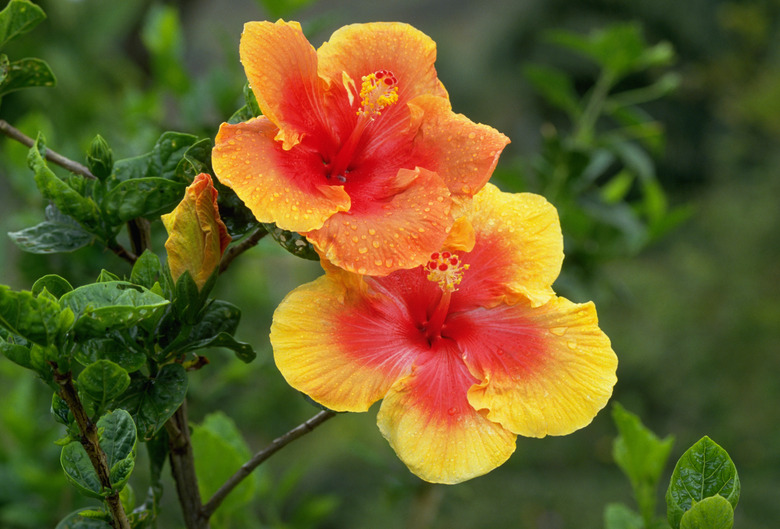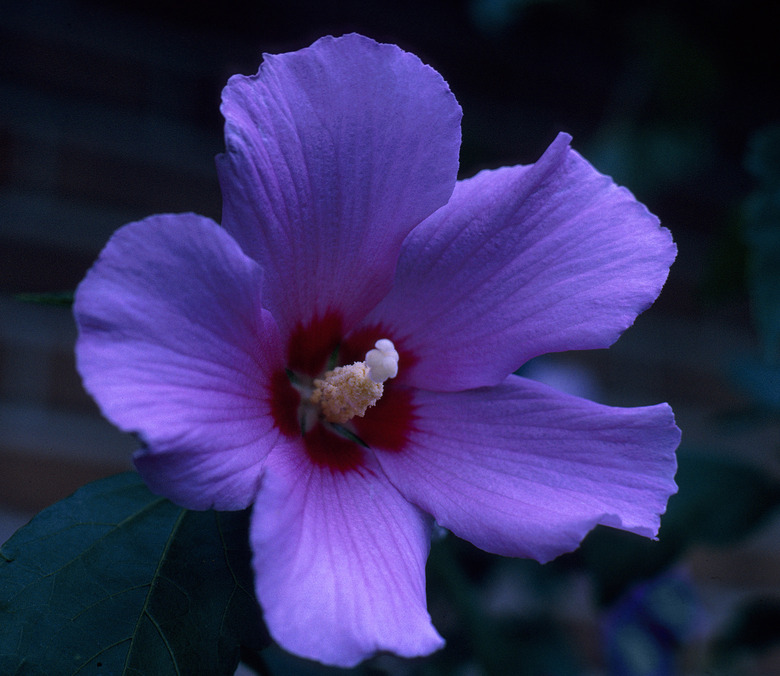How To Transplant Hibiscus Trees
Flowering Hibiscus: Shrub, Tree or Herb?
Is your flowering hibiscus (Hibiscus spp.) a shrub, a tree or even an herb? The answer to these questions helps you learn how to properly transplant your hibiscus, as there are differences among them to do with their sizes, growth habits and stems.
Stems and Branches
If your plant is an herb, its stem is soft and not at all like wood. A shrub has a woody stem, but it's not as thick as that of a tree. The branches on shrubs originate at the base, while the tree's branches grow from a central trunk.
Size
Size is another way to differentiate among a hibiscus herb, shrub or tree, with the tree the largest of the varieties. To add to the confusion, the hibiscus isn't really considered a tree at all, even though it grows like one.
Temperatures
Hibiscus is a tropical plant that enjoys warm breezes, soil and air temperatures that don't dip below 50°F. In the North, hibiscus needs to be conditioned to life in a container, because it can only survive in USDA hardiness zones 10 to 12 in the winter.
However, if it's a hardy hibiscus (Hibiscus moscheutos) that's been bred to survive in the cooler temperatures of hardiness zones 4 through 9 and is classified as a perennial, it can survive the winter temperatures as it dies down to the ground during the colder months and comes back again in late spring.
Rose of Sharon
Rose of Sharon (Hibiscus syriacus) is the name assigned to a specific hibiscus that has been trained and nurtured to grow tall. One of the easiest of the hibiscus varieties to grow, the Rose of Sharon can reach up to 12 feet tall and 10 feet wide.
Transplanting a Rose of Sharon, especially when it reaches maturity, isn't easy because of the size of the tree.
What You Need to Transplant a Hibiscus
- Shovel
- Helpers
- Potato sacks
- Stakes
- Mixture of soil and peat moss
- Water
Hibiscus needs loose, well-draining soil and full sun, although it is tolerant of drought, heat and humidity. If possible, transplant your hibiscus when it's young for an easier task. The older the plant becomes, the more difficult it is to transplant and the more temperamental it becomes. Moreover, you'll need more helpers if it's large.
**Transplant a hardy hibiscus in early spring, just after the last frost and when the ground is easy to work.** An annual tropical hibiscus, when transplanting it from an indoor container to a permanent spot outdoors, needs to be conditioned, or "hardened off" to its new environment prior to transplanting. Move the container outdoors for several hours daily, alternating between shade and sun and be sure to give it adequate water after the transplant.
Walk around the tree and give it a good look. Remove any aging stems or flowers. Also ensure it's healthy, not suffering from stress and hasn't lived through dramatic weather just prior to transplanting. If necessary, trim the branches.
Removing the Hibiscus From the Ground
Determine the best new spot for your hibiscus, one in which it gets sun and little wind. Gradually introduce your hibiscus to the new location if it's in a container before transplanting to let it get used to the new conditions. Once the tree is acclimatized, you can prepare it for transplantation—ideally in spring or at least late winter after the frosts are over.
Prepare the new location by digging a hole for the root ball that's at least 1 foot wider than it. Set aside soil to backfill.
With the shovel, dig around the base of the container tree at a distance of at least 1 foot until it is loose from the soil. Rocking it back and forth will help. Dig deep, until you reach the bottom of the container; then it should be easy to lift out the tree. But be gentle because the root system is delicate. This task may require some helpers if the tree is heavy.
It's best to wrap the root ball in a potato sack or other wrapping while transporting it to the new location. This keeps the roots intact and undamaged. Just don't try to brush soil away from the roots as it may damage them.
Tip
Plant in the spring for the best chance at success.
Placing the Hibiscus Into the Ground
After roughing up the bottom of the hole in preparation, place the tree in its new location. Fill the hole three-quarters full; add water and pat down the soil around the plant.
Install stakes around the trunk to stabilize the hibiscus; then finish filling the hole with a peat/soil mixture. Water every two to three days, but don't drench it.
Warning
When it comes to watering, the soil should be moist, not soggy.
Treating Transplant Shock in Hibiscus Plants
While getting used to its new environment, your hibiscus' leaves may start drooping or turning yellow and buds may drop. This condition is known as transplant shock and, with a few gentle treatments and time, the plant will recover.
Check the water level to ensure the plant is well hydrated, down to the roots. Dip a finger at least 1 inch into the surrounding soil to check for moisture. If it's dry, give the plant a lengthy watering.
Fertilize initially after transplanting with the appropriate 10-10-10 mixture. Follow up with 12-4-8 to supplement, as the mature hibiscus needs a large quantity of nitrogen and potassium for optimum health. Choose a liquid fertilizer as it reaches the plant's roots almost immediately.
Add mulch around the base of the plant to ensure the moisture remains, especially if it's in the hot sun.

